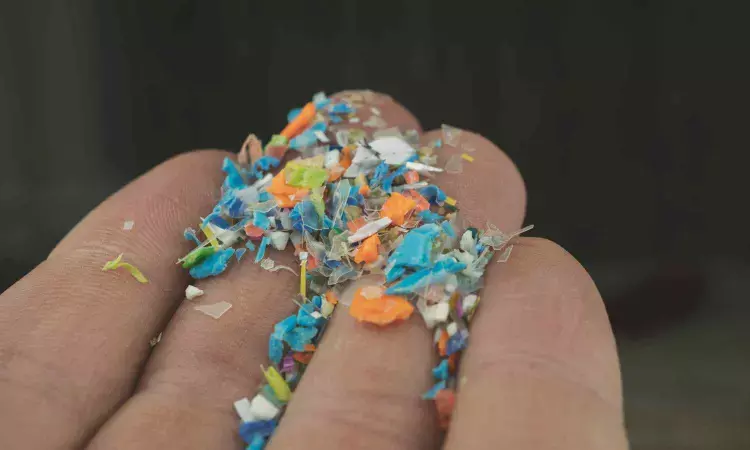- Home
- Medical news & Guidelines
- Anesthesiology
- Cardiology and CTVS
- Critical Care
- Dentistry
- Dermatology
- Diabetes and Endocrinology
- ENT
- Gastroenterology
- Medicine
- Nephrology
- Neurology
- Obstretics-Gynaecology
- Oncology
- Ophthalmology
- Orthopaedics
- Pediatrics-Neonatology
- Psychiatry
- Pulmonology
- Radiology
- Surgery
- Urology
- Laboratory Medicine
- Diet
- Nursing
- Paramedical
- Physiotherapy
- Health news
- Fact Check
- Bone Health Fact Check
- Brain Health Fact Check
- Cancer Related Fact Check
- Child Care Fact Check
- Dental and oral health fact check
- Diabetes and metabolic health fact check
- Diet and Nutrition Fact Check
- Eye and ENT Care Fact Check
- Fitness fact check
- Gut health fact check
- Heart health fact check
- Kidney health fact check
- Medical education fact check
- Men's health fact check
- Respiratory fact check
- Skin and hair care fact check
- Vaccine and Immunization fact check
- Women's health fact check
- AYUSH
- State News
- Andaman and Nicobar Islands
- Andhra Pradesh
- Arunachal Pradesh
- Assam
- Bihar
- Chandigarh
- Chattisgarh
- Dadra and Nagar Haveli
- Daman and Diu
- Delhi
- Goa
- Gujarat
- Haryana
- Himachal Pradesh
- Jammu & Kashmir
- Jharkhand
- Karnataka
- Kerala
- Ladakh
- Lakshadweep
- Madhya Pradesh
- Maharashtra
- Manipur
- Meghalaya
- Mizoram
- Nagaland
- Odisha
- Puducherry
- Punjab
- Rajasthan
- Sikkim
- Tamil Nadu
- Telangana
- Tripura
- Uttar Pradesh
- Uttrakhand
- West Bengal
- Medical Education
- Industry
Study reports microplastic presence in effusion fluid of children with otitis media: Study

A new study published in the International Journal of Pediatric Otorhinolaryngology revealed that microplastics are present in the middle ear effusions (MEEs) in otitis media with effusion (OME) patients, which calls for more research into any possible ramifications.
9 out of 10 children will experience at least one episode of otitis media with effusion (OME), which is defined by middle ear fluid collection without acute infection symptoms. OME requires close observation because of the possibility of long-term consequences, including as learning disabilities, delayed language development, and adhesive otitis media. Although usually sterile, the part that bacteria and biofilms play in the pathophysiology of OME has recently come to light, pointing to possible treatment targets.
Because of anthropogenic pollution, microplastics are becoming more and more common in the global biosphere and may be harmful to human health. Clothing, paints, cleaning supplies, and cosmetics are some of the sources, which produce a variety of sizes and forms. Microplastics can include biofilms that promote microbial survival, including potentially harmful species, and can create microhabitats that have an impact on human health.
More research is necessary to fully understand the toxicity of microplastics and their possible function as infection vectors. Thus, to clarify a possible connection between ambient microplastic exposure and this prevalent pediatric ailment, this study examines the presence of microplastics in middle ear effusions in individuals with OME.
Almost, 24 patients (13 men and 11 women; mean age 5.4 years) with bilateral OME (≥3 months duration) or unilateral OME (≥9 months duration) having myringotomy had middle ear effusions taken. After aspirating the diffusions, they were cleaned with filtered distilled water, subjected to 10% KOH, and then allowed to incubate. After passing through a 0.7 μm glass fiber filter, the samples were cleaned with acetone and dyed with rose bengal. Raman microscopy and Fourier transform infrared spectroscopy were used to evaluate the presence and characteristics of microplastics.
A total of 11 out of 40 MEE samples (27.5%) had microplastics. Bilateral microplastic presence was seen in two cases. Acrylonitrile butadiene styrene, polymethyl siloxane, polyurethane glycol, polyethylene diethyl chlorophosphite, polypropylene, and polyamide were among the microplastics that were found.
Overall, this study is the first to show that microplastics are present in the middle ear of humans. This discovery contributes to the increasing amount of data showing the buildup of microplastics in different human organs and tissues. The possible contribution of microplastics to OME development and their wider effects on middle ear health require more study.
Source:
Kökoğlu, K., Mıhçıokur, H., Uyanık, I., Öztürk, D., Yıldız, H., Taş, O. B., & Kaplan, R. A. (2025). Microplastic presence in the fluid of otitis media with effusion. International Journal of Pediatric Otorhinolaryngology, 196(112501), 112501. https://doi.org/10.1016/j.ijporl.2025.112501
Neuroscience Masters graduate
Jacinthlyn Sylvia, a Neuroscience Master's graduate from Chennai has worked extensively in deciphering the neurobiology of cognition and motor control in aging. She also has spread-out exposure to Neurosurgery from her Bachelor’s. She is currently involved in active Neuro-Oncology research. She is an upcoming neuroscientist with a fiery passion for writing. Her news cover at Medical Dialogues feature recent discoveries and updates from the healthcare and biomedical research fields. She can be reached at editorial@medicaldialogues.in
Dr Kamal Kant Kohli-MBBS, DTCD- a chest specialist with more than 30 years of practice and a flair for writing clinical articles, Dr Kamal Kant Kohli joined Medical Dialogues as a Chief Editor of Medical News. Besides writing articles, as an editor, he proofreads and verifies all the medical content published on Medical Dialogues including those coming from journals, studies,medical conferences,guidelines etc. Email: drkohli@medicaldialogues.in. Contact no. 011-43720751


